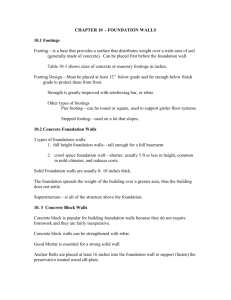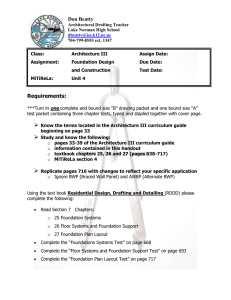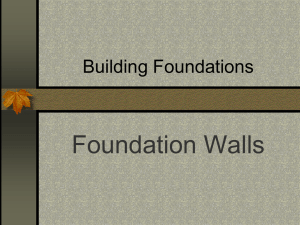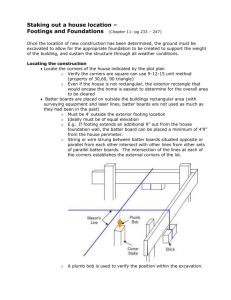section 7 - County of Sonoma
advertisement
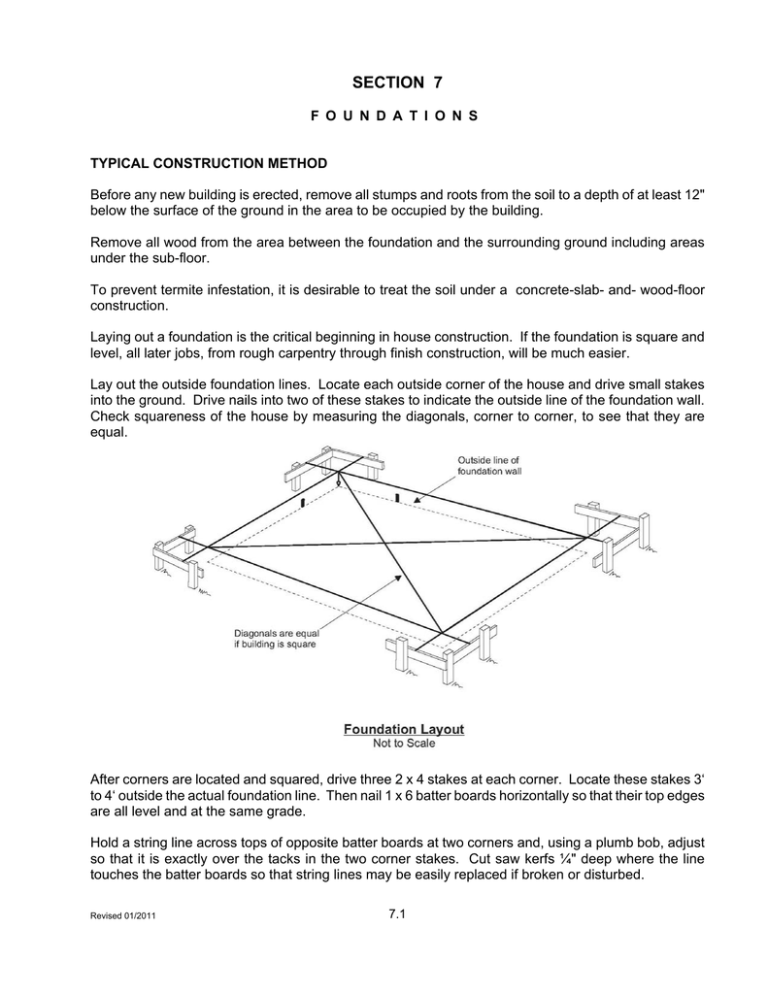
SECTION 7 F O U N D A T I O N S TYPICAL CONSTRUCTION METHOD Before any new building is erected, remove all stumps and roots from the soil to a depth of at least 12" below the surface of the ground in the area to be occupied by the building. Remove all wood from the area between the foundation and the surrounding ground including areas under the sub-floor. To prevent termite infestation, it is desirable to treat the soil under a concrete-slab- and- wood-floor construction. Laying out a foundation is the critical beginning in house construction. If the foundation is square and level, all later jobs, from rough carpentry through finish construction, will be much easier. Lay out the outside foundation lines. Locate each outside corner of the house and drive small stakes into the ground. Drive nails into two of these stakes to indicate the outside line of the foundation wall. Check squareness of the house by measuring the diagonals, corner to corner, to see that they are equal. After corners are located and squared, drive three 2 x 4 stakes at each corner. Locate these stakes 3‘ to 4‘ outside the actual foundation line. Then nail 1 x 6 batter boards horizontally so that their top edges are all level and at the same grade. Hold a string line across tops of opposite batter boards at two corners and, using a plumb bob, adjust so that it is exactly over the tacks in the two corner stakes. Cut saw kerfs ¼" deep where the line touches the batter boards so that string lines may be easily replaced if broken or disturbed. Revised 01/2011 7.1 FOUNDATION DESIGN CRITERIA FOUNDATION REQUIREMENTS. Continuous reinforced concrete footings are required under exterior walls, bearing walls, at garage door openings, and around any exterior covered floor area. Individual footing pads may be used when justified by calculations. Interior bearing walls on girders may be supported by isolated footings. EXPANSIVE OR LIQUEFIABLE SOILS. When expansive or liquefiable soils are present, the building code requires that special provisions be made in the foundation design and construction to safeguard against damage due to these potentially damaging soil conditions. The building code requires a special investigation and report to provide design and construction criteria for foundations located in expansive or liquefiable soils. STEPPED FOOTING. Foundations for all buildings where the bottom of the footing trench slopes more than 1‘ in 10‘ shall be stepped so that both top and bottom of such foundation are level. PIER AND GRADE BEAM. The use of a pier and grade beam system requires the submission of engineer or architect's design calculations, including required reinforcing bars. Special inspections are required for drilled cast-in-place piers or caissons. CONCRETE. Minimum strength of concrete for foundation construction shall be 3,000 psi at 28 days (May be reduced to 2,500 psi if licensed design professional documents classes for exposure categories of F0, S0, P0, and C0 in accordance with Table 4.2.1 of ACI 318-08). REINFORCING. Concrete stem walls shall have one bar of #4 (½" diameter) rebar 3" from the top and one bar of #4 rebar 3" from the bottom of the footings. Additional reinforcement must be provided if these bars are over 18" apart so that maximum spacing between horizontal bars is no greater than 18". Use #4 vertical bars at 18" o.c. if the stem wall is over 2 feet above footing, or if cold joint occurs in construction. Lap rebar 30 bar diameters (15" min). Concrete stem walls designed under the CRC shall have a minimum of one #4 bar located within 12" of the top of the wall and one #4 bar located 3"-4" from the bottom of the footing. See drawing on page 7.5 for sample rebar layouts. FOUNDATION PLATES OR SILLS. All foundation plates or sills and sleepers which rest on concrete or masonry shall be pressure-treated. When shear nailing spacing requirement is less than 4 inches, then foundation plate/sill shall be 3-inch nominal thicker or wider and nailing shall be staggered. When 3-inch nominal or greater foundation plate/sill are used then anchor bolt length will need to be increased. Foundation plates or sills shall be bolted to the foundation wall using anchor bolts. Anchor bolts shall be a minimum ½-inch diameter in Seismic Design Category (SDC) D or e-inch diameter in SDC E (SDC E shall be assumed unless it can be documented that the proposed structure is in SDC D). Anchor bolts shall be embedded at least 7" into the concrete and spaced not more than 6‘ on center. Anchor bolt spacing shall be designed by a licensed architect or engineer for buildings three stories or greater. A minimum of 2 bolts for each sill with 12" maximum distance from the ends of each sill is required. Steel plate washers a minimum of 3" by 3" by 0.229 inches thick shall be used on each bolt. FOUNDATION VENTILATION. Foundation ventilation requirements can be met by providing a net area of not less than one square foot for each 150 square foot of underfloor area, with openings as close to corners as practical on at least two opposite sides for full cross ventilation. Openings shall be screened with corrosion-resistant wire mesh with mesh openings of ¼" to ½" in dimension. Revised 01/2011 7.2 FOUNDATION ACCESS. Underfloor areas shall be provided with a minimum 18" by 24" access opening unobstructed by pipes, ducts, and similar construction. Underfloor plumbing cleanouts must be within 20‘ of a foundation or underfloor access. CONCRETE SLABS. Concrete slabs require footings reinforced with two #4 (½" diameter) bars of reinforcing steel under bearing walls and garage opening. Slabs must be a minimum of 3½" thick. Slabs under a living area and in garages shall be reinforced with wire mesh or rebar. Separate slab from soil with a minimum 6 mil waterproof membrane under living areas. FOUNDATION AND CONCRETE SLAB CONSTRUCTION GROUNDING ELECTRODE IN FOUNDATION. An electrode encased by at least 2" of concrete, located within and near the bottom of a concrete foundation or footing that is in direct contact with the earth, consisting of at least 20‘ of one or more steel reinforcing bars or rods of not less than 1/2" diameter, or consisting of at least 20‘ of bare solid copper conductor not smaller than #4 AWG. (See Section 17, Electrical) is required to ensure proper grounding. Revised 01/2011 7.3 FOUNDATIONS FOR STUD BEARING WALLS – MINIMUM REQUIREMENTS1,2,3,4,5 NUMBER OF FLOORS SUPPORTED BY THE FOUNDATION THICKNESS OF CONCRETE FOUNDATION WALL6 WIDTH OF FOOTING THICKNESS OF FOOTING DEPTH BELOW UNDISTURBED GROUND SURFACE (inches) (inches) (inches) (inches) 1 6 12 6 12 2 6 15 6 12 1. Source: 2010 CBC, 2010 CRC 2. The ground under the floor may be excavated to the elevation of the top of the footing. 3. Interior stud bearing walls are permitted to be supported by isolated footings. The footing width and length shall be twice the width shown in this table, and the footings shall be spaced not more than 6 feet on center. 4. Footings are permitted to support a roof in addition to the stipulated number of floors. Footings supporting roof only shall be as required for supporting one floor. 5. Freestanding accessory structures not used for human occupancy and not over 400 square feet in floor area with an eave height of 10 feet or less may be constructed with walls supported on wood or metal foundation plate(s). 6. Foundation walls exceeding 4'6" height shall be 7.5" minimum thickness. Revised 01/2011 7.4 Revised 01/2011 7.5 STEPPED FOOTINGS A stepped footing is required if the bottom of the footing slopes more than 10% (10 units horizontal to 1 unit vertical). If the earth slope is steeper than 33a% (3 units horizontal to 1 unit vertical), a detail prepared by a licensed professional (architect/engineer) is required. A soils report may also be required. Where the bottom of a footing is stepped and cripple wall height varies more than 4 feet along a wall line strapping is required at the joint between the area where the lowest floor framing rests directly on a sill bolted to a footing and the cripple wall. The double plate of the cripple stud wall shall be spliced to the sill plate with metal tie strapping, one on the interior and one on the exterior as shown in the diagram above. Non-engineered foundation walls shall not exceed 8 feet in height nor extending above the floor framing for the first floor. A maximum of 4 feet of unbalanced fill is permitted for nonengineered foundation walls. Width of concrete foundation walls shall be as shown in the table on Page 7.4. Sleepers and sills on concrete that is in direct contact with earth shall be pressure treated, or heartwood of Redwood or Eastern Red Cedar. Revised 01/2011 7.6 Foundation Setbacks from Slopes These drawings supplement Section 1808.7 in the California Building Code. The figures apply to slopes from 3 horizontal and 1 vertical (3:1 or 33% slope) to 1 horizontal and 1 vertical (1:1 or 100% slope). These requirements are designed to provide protection from slope drainage, erosion and shallow failures. In cases where adequate setback cannot be provided PRMD may require that a geotechnical investigation report be provided. In all cases footings must extend a minimum of 12 inches below undisturbed ground surface. The ground adjacent to the foundation shall be sloped 20:1 (5%) for 10 feet or if not physically possible provide 5% slope to an approved alternative method for diverting water. Swales used for this shall be min. 2% when within 10 feet of the building. Minimum slope for paved surfaces shall be 2%. Revised 01/2011 7.7 HOLDOWN DETAILS Holdown sizes HD2A, PHD2, HD5A Stemwall minimum thickness 7½" Concrete 2500 psi minimum Bolt Minimum Embedment Depth Mono Pour SSTB 16 12-5/8" Two Pour SSTB 20 16-5/8" Please consult the catalog of the specific holdown manufacturer for approved installation instructions. Simpson, USP, KC Metal, and other firms all provide installation instructions. Revised 01/2011 7.8
